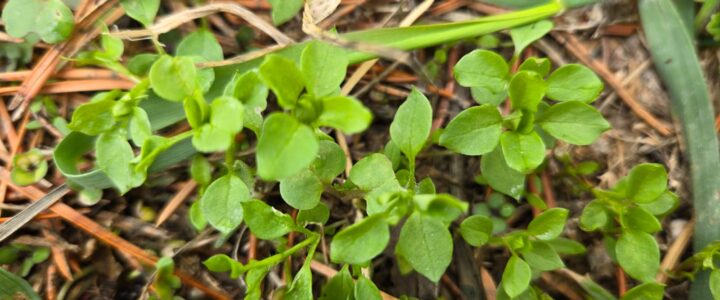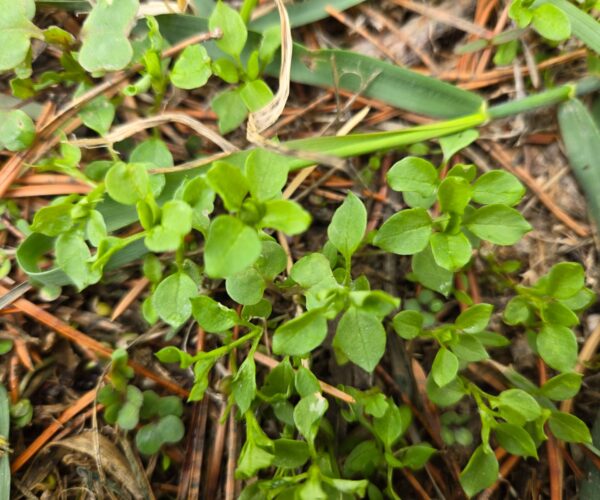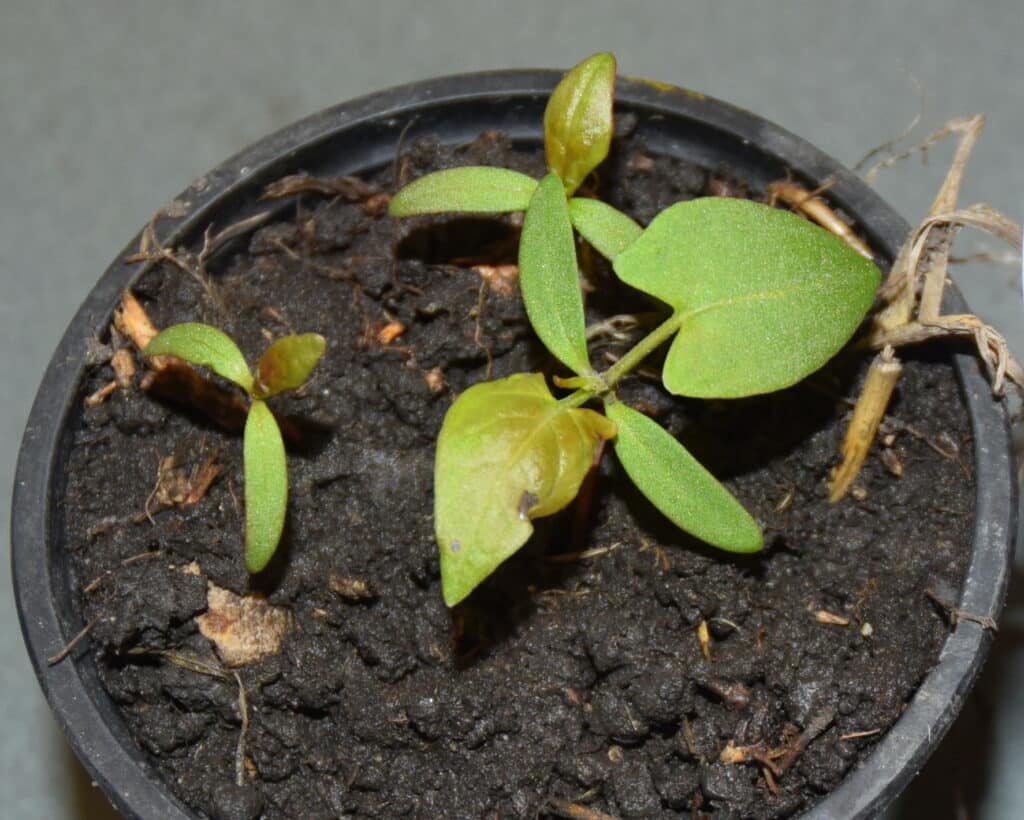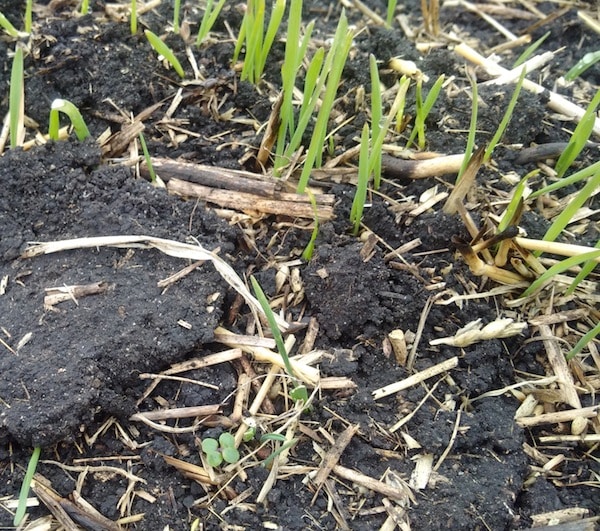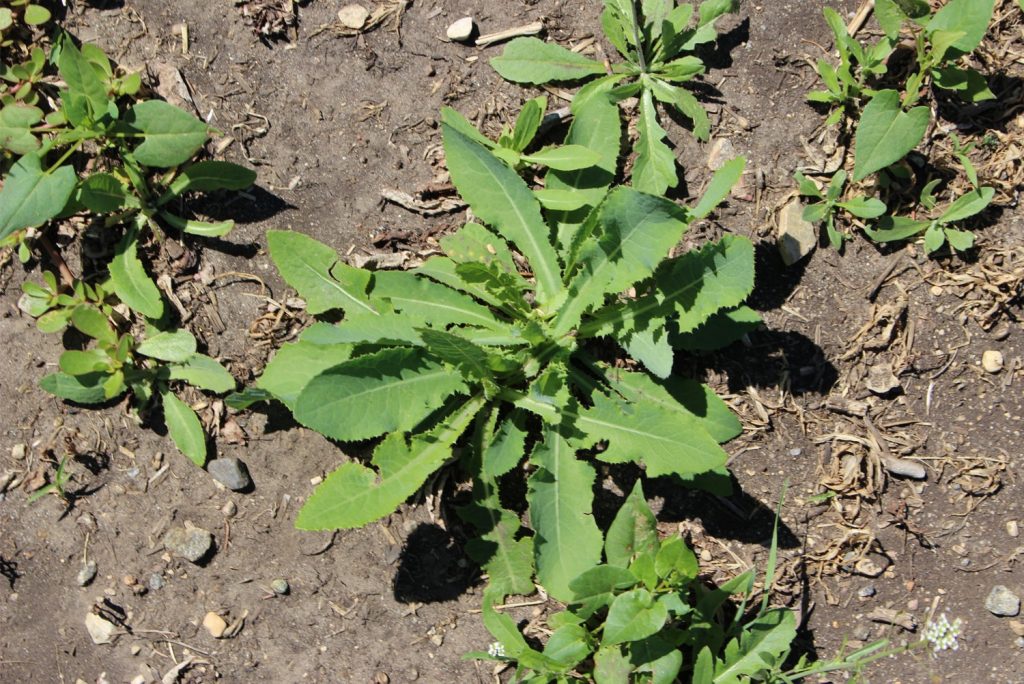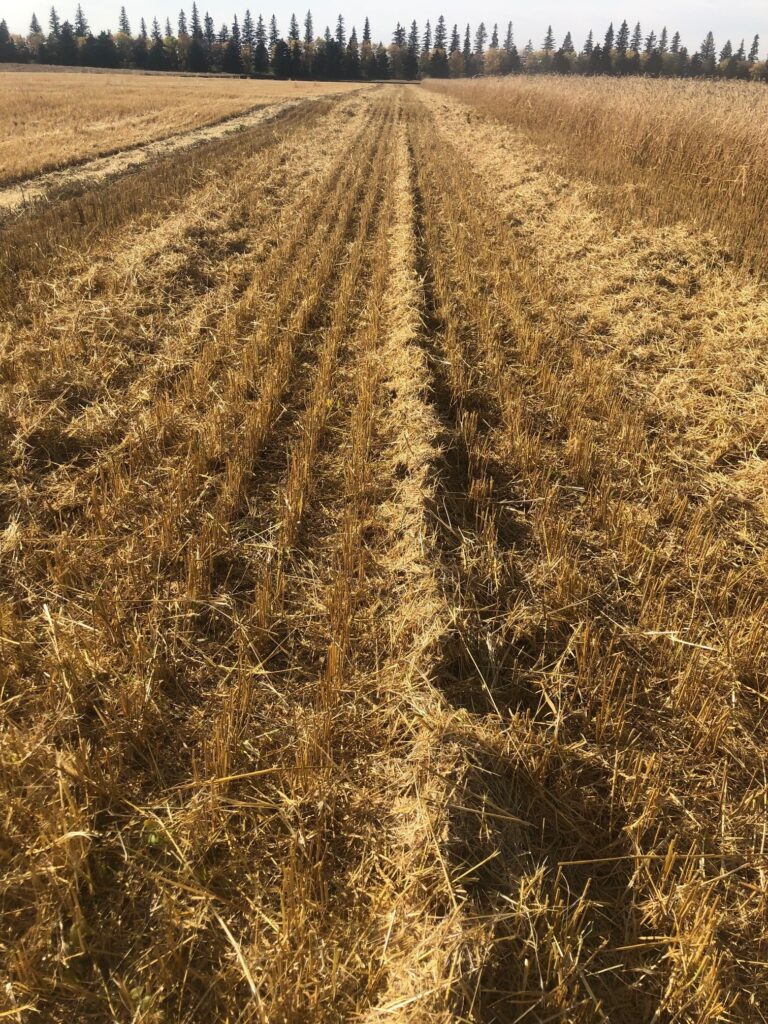Weeds contribute to crop yield loss every year. In addition to weed abundance challenges, there is a growing list of herbicide-resistant weeds in Western Canada, both in terms of the herbicide groups that they are resistant to and the locations that weed species have been confirmed in.
Prairie weed overview
The new Prairie Weed Monitoring Network (PWMN) showcases provincial weed survey results on weed abundance and herbicide resistance. It also features maps of various herbicide-resistant weeds in Saskatchewan and an informative Herbicide Resistant Weeds in the Prairie Region poster (pictured below) of Prairie weed species that have resistance to select herbicide groups (based on their mode of action). The prevalence and distribution of herbicide-resistant weeds depicted in these resources emphasizes the need for additional weed management strategies to supplement chemical weed control options.
As explained in this paper, integrated weed management (IWM) includes a combination of cultural, physical, or biological control strategies in addition to herbicide-based management options. No single strategy is expected to manage all weeds in all crops with IWM. Instead, it includes multiple options that can together offer a more robust longer term solution if effectively implement. Since every generation of the weed life cycle has the potential to produce exponentially more weeds, early adoption of integrated weed management is the best chance for success.
Apply this research on your farm
- Start soon – Adopt IWM before herbicide resistance is established, for best success.
- Implement Canola Watch’s Integrated weed management: Best practices
- Check out the Herbicide Resistant Weeds in the Prairie Region poster and these weed management resources.
- Tailor management tactics to specific weed species and use multiple strategies.
- Remember harvest weed seed control. Use both early and late season strategies.
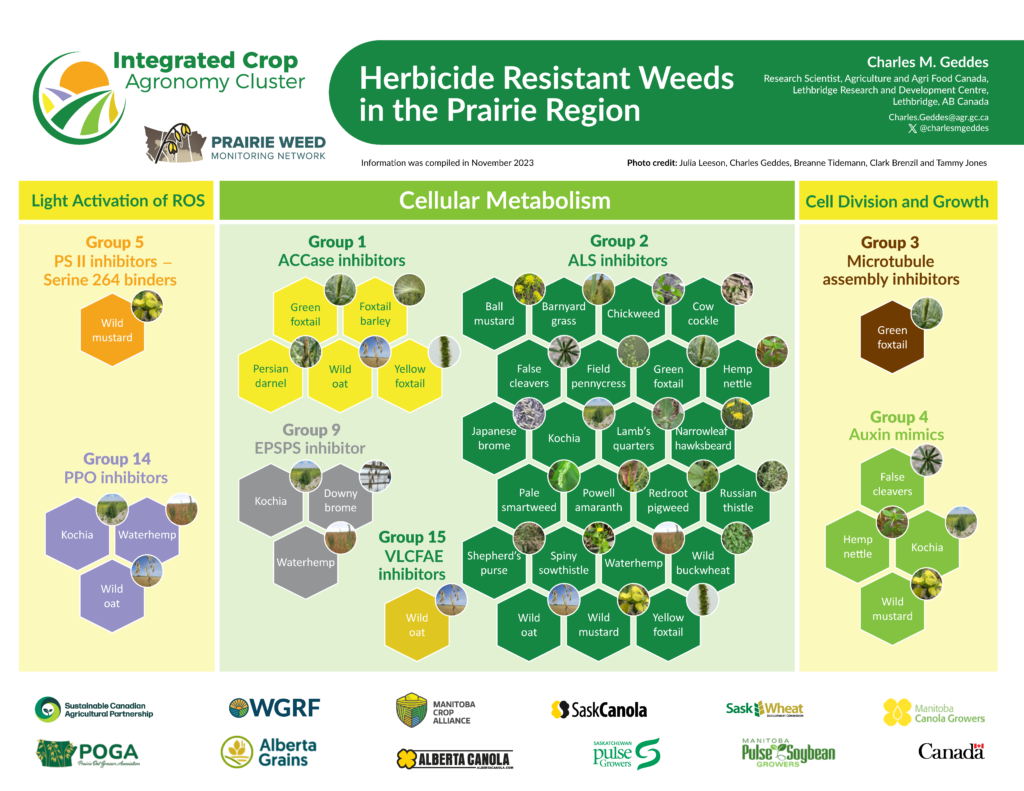
Herbicide resistance research
Tidemann’s five-year (2016-2020) Mitigating herbicide resistance – investigating novel integrated weed management systems project, which builds on previous research, examined IWM tactics to manage wild oat, wild buckwheat, and locally-important broadleaf weeds (ex. cleavers at Lacombe and kochia at Lethbridge) at six Prairie locations (Beaverlodge, Lacombe, and Lethbridge, AB; Scott and Saskatoon, SK; and Carman, MB).
Weed populations were measured for plots with diverse crop rotations (canola-wheat, faba beans-barley-canola, peas-winter wheat-canola, silage barley-winter triticale-silage barley, silage barley-fall rye-canola, alfalfa-alfalfa-alfalfa), with and without herbicides (various combinations), typical or increased seeding rates, and with and without chaff collection.
To allow weed populations to establish, trials were seeded to wheat at double the seeding rate and not treated with herbicides in year one, and again in year five. The diverse crop rotations were planted over years two, three and four.
Both the impact of a single species as well as a full weed community (such as a broadleaf species, a grass weed species and other dominant weed species in the area) were investigated, along with economic considerations. Managing multiple weed species (and each of their life cycles) is challenging in research and on farms, especially when strategies that control one species may not address another species.
Weed community and species-specific findings
Wild buckwheat populations were not significantly affected (on average) by any of the crop rotations or integrated weed management techniques tested, across locations. This may have been due to the twining/climbing nature of buckwheat which makes it more resilient to the IWM strategies that rely on increased crop competitiveness to reduce weed impacts.
As noted in a previous blog, the grass weeds – especially wild oats – were found to be more competitive than broadleaf weeds (and can reduce the size and impact of broadleaf weeds). For instance, the reduction in broadleaf weed biomass in the low diversity, no herbicide treatment may have been due to the high and competitive wild oat populations in the same plots.
Wild oat management strategies that were previously studied (ex. increased seeding rates and inclusion of a winter cereal or barley silage) weren’t always effective for controlling wild oats or other species in this study. The research team suggested that this could be the result of IWM strategies being less effective on high weed populations. This emphasizes the need for early adoption, because once resistance is established (and densities increase) it will be much harder to control.
The use of silage barley and winter cereals provided some efficacy in managing weed communities or species. But the economics and marketability of these crops would need to be considered before it can be considered a recommended solution.
Herbicide resistance management tactics
The peer-reviewed paper generated from this research, Using integrated weed management systems to manage herbicide-resistant weeds in the Canadian Prairies, features an excellent summary of the impact of different strategies on various weed species (based on this study’s results). It includes:
- The use of chaff collection, early cut silage and reduced canola in a rotation was effective in managing volunteer canola.
- The inclusion of winter annuals and perennials in a rotation along with herbicides was effective for managing lambsquarters.
- Increased seeding rate, a diverse crop rotation with the use of herbicides and in some areas, the inclusion of alfalfa, were all ineffective cleavers management strategies.
- The inclusion of winter annuals and perennials in a rotation, no in-crop herbicides, chaff collection and increased seeding rate were effective for managing kochia.
- The inclusion of alfalfa into the rotation along with diversified rotations without herbicides was effective redroot pigweed management.
- The use of winter cereals with poor survival, increased seeding rate alone and a diversified spring annual rotation were not effective at managing wild oats (or foxtail species).
- However, incorporating alfalfa into a diversified rotation, competitive winter cereals with two years of silage barley, chaff collection with herbicides, and increased seeding rates in combination with other tactics was effective management for wild oats and foxtail species.
Therefore, the use of IWM strategies to manage weed species and weed communities can support reduced herbicide resistance pressure (and herbicide reliance), but additional research is needed for further understanding.
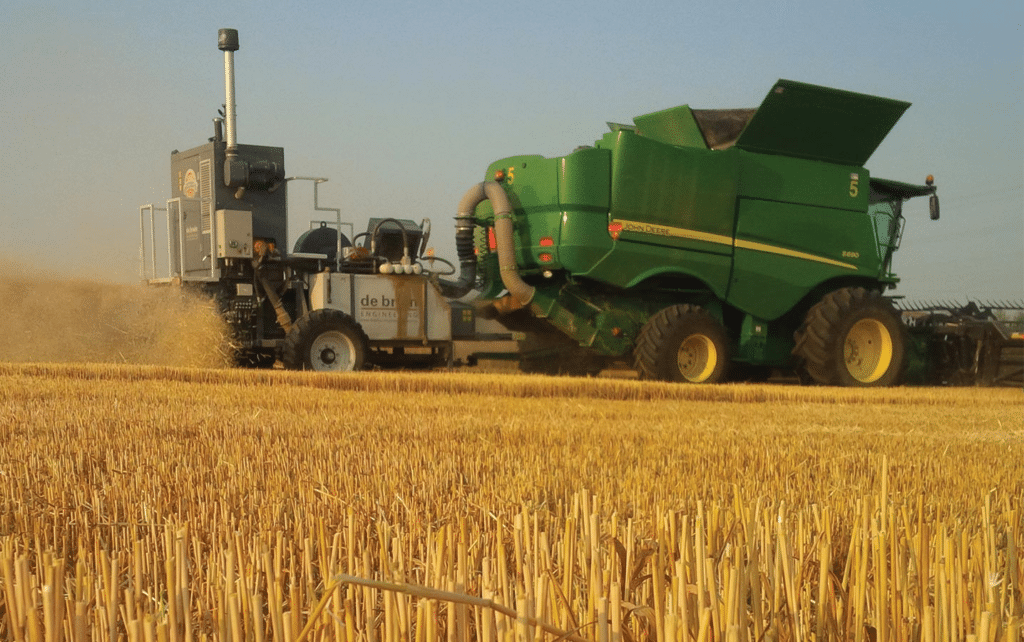
Harvest weed seed control
The concept of managing weeds which have survived until harvest so that they don’t contribute to the seedbank for future seasons is called harvest weed seed control. There are many different harvest weed seed control techniques. One method of harvest weed seed control is the use of physical impact mills. The original tow-behind Harrington Seed Destructor is an example of an impact mill, as well as the newer versions that are integrated into combines.
Harrington Seed Destructor efficacy
Tidemann’s Harrington seed destructor evaluation at field scale in Alberta project tested the efficacy of this physical impact mill for weed management. Treated (when the destructor was used) and untreated (when the destructor wasn’t used) replicates were measured in 20 Alberta producer fields (that had a range of weed species in them) over three years (2017-2019). Seedling counts were conducted the following springs (2018-2020) and weed seedbank samples were collected in the last year of the project (2020).
Seedling count results generally showed minimal statistically significant differences in weed seedling populations. There are some numeric trends that could suggest early success in managing a few weed species in these fields, but not all of them. More specifically:
- Fields with volunteer canola and sowthistle species produced greater weed populations when the destructor was used, than when it wasn’t.
- In one field the wild oat population increased and another field it decreased when the destructor was used (compared to when it wasn’t).
- Individual fields reported reductions for false cleavers, for hempnettle, for wild buckwheat and for chickweed when the destructor was used (but this was not the case across multiple fields).
Potential areas for improvement
Some potential explanations for the lack of significant efficacy that were mentioned in the related Field testing of a physical impact mill in the Canadian Prairies publication were:
- The limited use (or reported use) of a pre-seeding herbicide application by farmers in the study, as this practice may help maximize weed control when using a physical impact mill.
- The fields used in this study already had dense weed populations (and may have been so high that a reduction in seeds wouldn’t have impacted the seedling population).
- Alternatively, there may have been a large amount of variation in weed populations between plots (prior to the trials) which impacted the results.
- Many weed species in this study have long lasting seedbanks, which exceed the length of the study (such as wild oat seeds, compared to a shorter seedbank weed like kochia).
- Various combine setting adjustments could better optimize the combine and destructor performance, both overall and for specific weed species.
Further longer term research with various adjustments could address some of these considerations and provide a more robust investigation into this potential weed management tool.
Chaff lining for potential weed control
Tidemann’s Suitability and efficacy of chaff lining for weed control in Western Canada project investigated a physical control method which involved concentrating the chaff into a narrow line behind the combine, to try to block weed seed emergence by smothering seeds in chaff.
To investigate seed viability of wild oat, cleavers, volunteer canola, kochia, green foxtail and wild buckwheat after an overwintering period under and beside chaff lines, researchers compared three different combines, three locations and four crops – canola, peas, wheat and barley or rye in this study. They also investigated weed seed movement and capture in chaff lines, crop and weed emergence after chaff lining, and the impact of chaff lines on soil fertility and plant nutrient status.
Impact of chaff lining
The results showed that weed seed viability was not reduced after overwintering under the chaff line, and in most cases, it increased compared to overwintering on bare ground – except for kochia seeds under the pea chaff line. Chaff lining was generally less effective on larger-seeded weeds (but could be more effective on small-seeded broadleaf weeds).
While weed emergence was reduced in chaff lines, canola emergence was also reduced by an average of 50 plants per square metre (where crop seeding rows intersected the chaff lines). The nutrient concentrations under the chaff lines were also highly inconsistent between sites.
Therefore further research and various alterations of this technique (and potentially different analysis) would be needed before this strategy could be used.
Related weeds science research
For additional information on weed management, check out the following completed studies or ongoing weed management projects:
- Harvest weed seed control in early- versus late-maturing crops
- Can harvest weed seed management be used to control kochia, cleavers and wild buckwheat?
- Glyphosate-or auxinic-resistant kochia and Russian thistle Prairie survey
- Assessing the influence of base germination temperature and chemical desiccants on the recruitment biology of cleavers (Galium species)
Weed management resources


Published November 6, 2024


